
Sponsored Ads
|
» Home
» Sports » George Mikan gentle giant and the first big dominant basketball player in the history of NBA has Croatian roots
» Home
» People » George Mikan gentle giant and the first big dominant basketball player in the history of NBA has Croatian roots
» Home
» Education » George Mikan gentle giant and the first big dominant basketball player in the history of NBA has Croatian roots
» Home
» Croatian Life Stories » George Mikan gentle giant and the first big dominant basketball player in the history of NBA has Croatian roots
| George Mikan gentle giant and the first big dominant basketball player in the history of NBA has Croatian roots |
| By Darko Žubrinić |
Published
07/20/2013
|
Sports , People , Education , Croatian Life Stories
|
Unrated
|
|
|
|
George Mikan was in the first class elected to the Naismith Memorial Basketball Hall of Fame in 1959, part 3
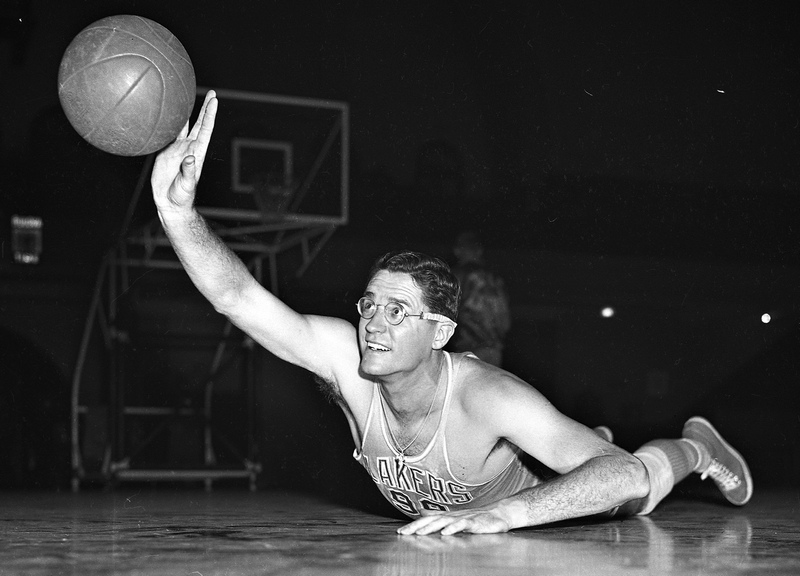 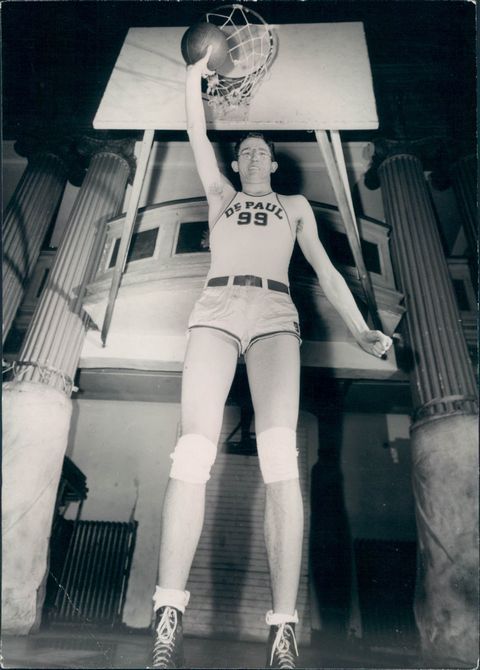
GEORGE MIKAN
It's hard to believe today, but until the 1940s basketball was considered a sport better suited to shorter men than to taller, less nimble players. George Mikan, a 6-10 giant of a man who possessed superior coordination and a fierce competitive spirit, was one of the prototypes for the dominating tall players of later decades. Towering over most of his competitors, he was one of the most effective scorers of his day, averaging 22.6 points over a professional career that lasted nine years -- one with the Chicago American Gears and eight with the Minneapolis Lakers.
Mikan was so hard to defend and to score against, in fact, that the NBA had to change its rules of play in order to keep him from completely overwhelming the league. Few players have had such a huge impact on the game. In 1950, Mikan was voted the greatest player of the first half of the century by The Associated Press.
GEORGE MIKAN
Full Name: George Lawrence Mikan Jr.
Born: 6/18/24 in Joliet, Ill.
Died: 6/1/05 in Scottsdale, Ariz.
College: DePaul
Signed by: Chicago American Gears of the NBL (1948)
Height: 6-10;
Weight: 245 lbs.
Honors: NBL Honors: NBL champion ('47, '48); MVP ('48); All-NBL First Team ('47, '48). BAA Honors: BAA champion (1949); All-BAA First Team (1949). Elected to Naismith Memorial Basketball Hall of Fame (1959); NBA champion (1950, '52, '53, '54); Five-time All-NBA First Team (1950-54); Four-time NBA All-Star (1951-54); All-Star MVP (1953); One of 50 Greatest Players in NBA History (1996).
In his nine professional seasons -- two in the National Basketball League, one in the Basketball Association of America, and six in the NBA -- Mikan's teams won seven championships. He was the cornerstone of the NBA's first dynasty, the Minneapolis Lakers of the early 1950s. Mikan led the NBA in scoring three times and in rebounding average twice and he played in the league's first four All-Star Games.
The notion that someone could be tall enough, and jump high enough, to deflect a ball while it was above the basket was unthinkable before the 1940s. But that changed when Mikan perfected the art of goaltending -- then a perfectly legal practice because it was considered impossible when he played college ball.
"We would set up a zone defense that had four men around the key and I guarded the basket," Mikan recalled. "When the other team took a shot, I'd just go up and tap it out." He swatted away so many would-be baskets at DePaul that the NCAA decided to outlaw goaltending.
Named College Player of the Year twice and an All-American three times, Mikan led DePaul to the NIT title in 1945. En route to the championship, he broke the collegiate single-game scoring record by pumping in 53 points against Rhode Island State -- a remarkable feat at the time, and made even more amazing by the fact that he single-handedly outscored the entire Rhode Island State team.
Mikan's debut as a professional came in 1946 after he was signed by the Chicago American Gears of the NBL, a predecessor of the NBA. Dominating the pro players as devastatingly as he had college players, Mikan scored 16.5 points per game in his rookie year, powered his team to victory in the league championship and was named to the All-NBL Team.
Before the start of the 1947-48 campaign, Maurice White, president of the American Gear Company and owner of the Chicago team, pulled the club out of the NBL. White's plan was to create a 24-team circuit called the Professional Basketball League of America, in which he would own all of the teams and all of the arenas. But the new league lasted barely a month, and the players on White's teams were distributed among the 11 remaining NBL franchises. The first-year Minneapolis Lakers landed Mikan strictly by chance.
Wearing a Lakers uniform in 1947-48, Mikan joined forward Jim Pollard to form an imposing Minneapolis front line. The Lakers dominated the NBL's Western Division, then rolled through the playoffs, winning a best-of-five championship series against the Rochester Royals in four games. After averaging 21.3 ppg in the regular season, Mikan poured in 27.5 points ppg in the Finals.
Before the 1948-49 season began, the Minneapolis Lakers, Rochester Royals, Fort Wayne Zollner Pistons and Indianapolis Kautskys (later renamed the Jets) had defected to the Basketball Association of America. The BAA was already a big-city, eight-team league with franchises in New York, Boston, Philadelphia and Chicago. And the addition of the four NBL teams gave the league the big-name players it needed.
Rochester and Minneapolis dueled for the top spot in the BAA's Western Division in 1948-49, but the Royals edged out the Lakers by one game, even though the broad-shouldered and extremely agile Mikan played with devastating force. He put up numbers that, by the standards of the day, were unbelievable. His league-leading average of 28.3 ppg accounted for one-third of the Lakers' point production. Only two other players in the league, Joe Fulks of Philadelphia and Max Zaslofsky of Chicago, managed to average more than 20 points.
In the 1949 BAA Playoffs, the Lakers advanced all the way to the Finals, where they faced the Washington Capitols, who were coached by Red Auerbach. Minneapolis notched three quick wins to open the best-of-seven series. In Game 4, Mikan sustained a broken wrist, and the Capitols escaped with a win. Mikan played Game 5 with a cast on his hand and pumped in 22 points, but Washington prevailed. Game 6 was played in St. Paul, where Minneapolis came away with a 77-56 victory and a BAA Championship. In 10 postseason contests, Mikan averaged 30.3 ppg.
The BAA and the NBL merged after that season, and the NBA was born for the 1949-50 campaign. In its first year, the NBA consisted of 17 teams competing in three divisions. Minneapolis was assigned to the Central Division (the strongest of the new circuit), where it went head-to-head once again with Rochester. Mikan topped the new league in scoring by averaging 27.4 ppg. Only Alex Groza of Indianapolis joined him in the 20-plus bracket.
Minneapolis, which finished the regular season at 51-17, waltzed through the preliminary rounds of the postseason. The powerful Lakers felled the Chicago Stags in the Central Division Semifinals, swept the Fort Wayne Pistons in two games in the division finals and then dusted the Anderson Duffey Packers in two games in the NBA Semifinals.
George Mikan was honored in 2001 with a statue at the Target Center in Minneapolis.
The NBA Finals in 1950 pitted the Lakers against the Syracuse Nationals. The Nats had the home-court advantage, but the Lakers took Game 1 in Syracuse when reserve guard Bob Harrison heaved in a 40-foot shot at the buzzer to give Minneapolis a two-point win. The Nationals evened the series the next night. When the Finals reconvened in Minnesota five days later, Minneapolis pounded out a 91-77 win, then followed with another victory in Game 4. Syracuse postponed the inevitable by shutting down Mikan in Game 5, but the Lakers came back with a 110-95 victory in Game 6, thereby earning the team's second straight championship. Mikan poured in 31.3 ppg in the playoffs.
The NBA began keeping track of rebound statistics in the 1950-51 season. Mikan was among the league's premier rebounders, pulling down an average of 14.1 rebounds per game, second only to Dolph Schayes's 16.4 rpg. But Schayes couldn't match Mikan in the scoring department, as the Lakers' center turned in a career-best average of 28.4 ppg, tops in the NBA.
For the first time since Mikan had begun playing professional basketball, his team did not win a championship. Minneapolis fell to Rochester in the Western Division Finals, three games to one, largely because Mikan hobbled through the series with a fractured leg. "The doctors taped a plate on it for the playoffs," Mikan told Newsday in 1990. "I played all right, scored in the 20s. I couldn't run, sort of hopped down the court."
Injured or healthy, Mikan was in his prime. Unlike other players in the league, he was able to draw large crowds wherever he went. People clamored to watch the bespectacled Goliath play with the grace and agility of men a foot shorter. From 1949 to 1954 he was named the center on the All-NBA First Team. He starred in the first four NBA All-Star Games, from 1951 to 1954, including a 26-point, 15-rebound performance in the 1952 contest. He could deliver hook shots with deadly accuracy using either hand. His two-handed set shot, the standard shot of his era, was usually on the money. And he could run the floor with surprising speed.
On both ends of the court, Mikan's style of play could be categorized as hard-nosed, as evidenced by the 10 broken bones he suffered and the 16 stitches he required during his playing years. As another sign of his rugged play, Mikan earned a place in the NBA record books by retiring with the most seasons (3) in which he led the league in personal fouls.
One of the legendary stories about Mikan concerns a game played on Dec.13, 1949, between the Lakers and the Knicks. The marquee over Madison Square Garden read: "Geo. Mikan vs. Knicks." When Mikan walked into the locker room before the game, he found his teammates sitting around in their street clothes. One of them greeted Mikan by saying, "They're advertising you're playing against the Knicks, so go play them. We'll wait here."
Mikan did seem to single-handedly overpower the rest of the league at times, so much so that the NBA tried to make it more difficult for him to score by expanding the width of the key, from 6 feet to 12 feet. The 24-second clock also came about because of Mikan. In a game in 1950, the Fort Wayne Pistons decided that the only way they could win was to hold onto the ball and not let the Lakers have it. They ended up winning, 19-18, in the lowest-scoring game in NBA history. The league implemented the 24-second shot clock a few seasons later.
1953-54 Lakers
George Mikan (No. 99) was the lynchpin of the 1953-54 World Champion Minneapolis Lakers.
NBA Photos
In the 1951-52 season, Mikan finally began his slow descent from the league's scoring pinnacle. His average of 23.8 ppg was almost five points lower than what it had been the previous year and his field-goal percentage dipped to .385 (from .428 the year before). One reason his production decreased was the rule change that widened the foul lane. Before that season, Mikan and other centers would play the pivot position almost directly underneath the basket, where the giants were particularly deadly when they got the ball.
Even with Mikan's decreased scoring contribution, he was still among the league's best rebounders, pulling down 13.5 rpg in 1951-52. And he still knew how to win. The Lakers regained the NBA crown in 1952, defeating the New York Knicks in a seven-game NBA Finals.
Although Mikan's point production continued to slide in 1952-53, he was still second in the league in scoring with an average of 20.6 ppg. It was also the only year he led the NBA in rebounding (based on total rebounds), posting a career-high 14.4 rpg average. In that year's All-Star Game, Mikan dominated the backboards and won the game's MVP Award. The Lakers were the class of the league again in 1953, winning a second straight championship with a five-game triumph over New York.
Mikan led the Lakers to yet another championship in 1954, marking their third straight crown and fifth in six seasons. Only the Boston Celtics (1959 to 1966) and the Chicago Bulls (1991 to 1993) would win three consecutive championships in the second half of the century (the Los Angles Lakers began the next century with three consecutive titles as well winning the NBA Finals 2000-2002. During the regular season Mikan, then 29 years old, ranked fourth in the NBA in scoring (18.1 ppg) and second in rebounding (14.3 rpg).
Mikan stunned the basketball world by announcing his retirement after the Lakers' 1954 championship run. "I had a family growing, and I decided that I wanted to be with them," he said. "I felt it was time to get started with the professional world outside of basketball."
With Mikan out of the picture, the Lakers weren't as dangerous, although they still placed second in their division and made the playoffs. By the middle of the 1955-56 season Mikan could no longer bear seeing his old team on a losing skid, and he shocked observers again by returning to the Lakers' lineup. But his long absence from the game had taken its toll, and he was able to summon only a fraction of his former abilities. He played in 37 games for the Lakers and averaged only 10.5 points. Despite Mikan's efforts, Minneapolis finished with a losing record and was eliminated from the playoffs in the first round. Mikan then hung up his sneakers for good.
John Kundla, who had coached the Lakers since their inception, stepped into the team's front office for 1957-58 and persuaded Mikan to assume the head coaching duties. Mikan's first and only coaching venture was a disaster. After Minneapolis stumbled to a 9-30 record early in the season, Mikan stepped down, returning the reins to Kundla. The team finished with a 19-53 record, last in the Western Division.
Mikan then devoted all his energies to his law career and to raising his large family. While practicing corporate and real estate law, he also bought and renovated buildings in Minneapolis. In 1967, he returned to the basketball world to become the first commissioner of the American Basketball Association. Faced with all the problems of trying to create and sustain a fledgling professional sports organization, Mikan came up with the novel idea of the league's multicolored basketball.
"We were trying to get the network television contract, and I thought the typical brown ball was very hard to see in a large auditorium," Mikan said. "I decided on a ball with different-colored panels of red, white and blue for three reasons. First, it was patriotic; second, the TV viewability was just fantastic; and third, because of the salability of the ball. The young kids really liked it. In fact, we ran product comparison tests and the youngsters invariably chose our ball over the others."
Mikan served as ABA commissioner until 1969. He disappeared from basketball for a while but then resurfaced in the mid-1980s as the head of a task force whose goal was to bring professional basketball back to Minneapolis. With the financial backing of local businessmen Harvey Ratner and Marv Wolfenson, Mikan successfully lobbied the NBA to add an expansion team in Minnesota for the 1989-90 season. The team became the Minnesota Timberwolves.
Mikan was in the first class elected to the Naismith Memorial Basketball Hall of Fame in 1959. One of the most dominant players ever to play the game, Mikan's contributions to the sport and his impact on the NBA still loom as large as his 6-10 frame and his accomplishments were further acknowledged when he was named a member of the NBA 50th Anniversary All-Time Team in 1996.
Mikan passed away on June 1, 2005. He was 80.
Source www.nba.com
| 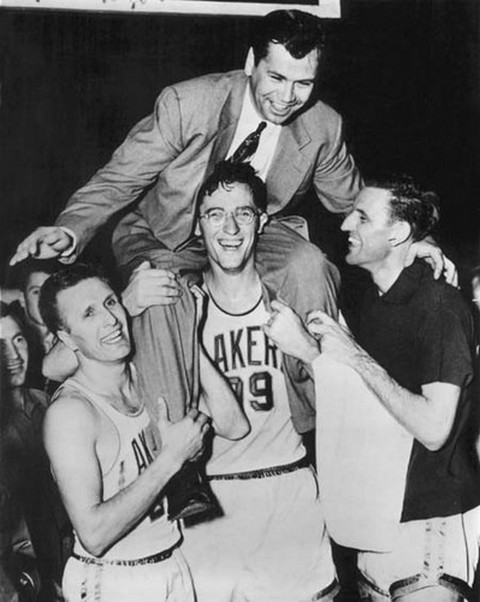 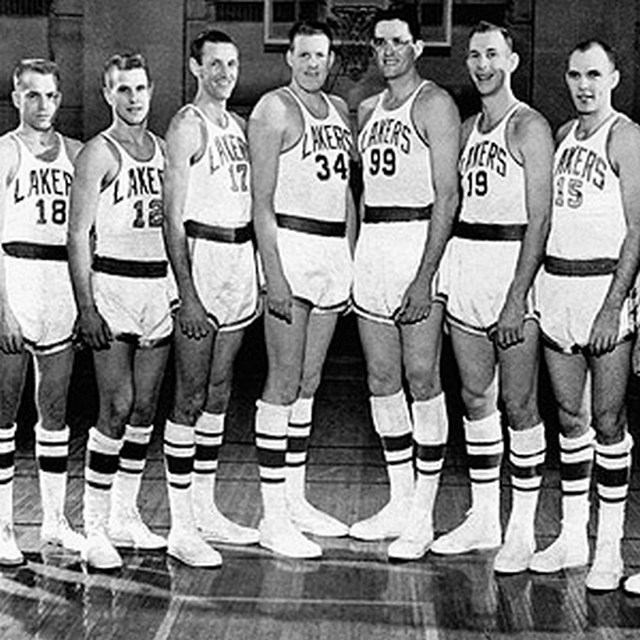 George Mikan No 99  Another monument of George Mikan in the USA  A monograph about George Mikan 
Michael Schumacher: Mr. Basketball - GEORGE MIKAN
Before Shaquille O'Neal and before Bill Russell, there was George Mikan, a six-foot-ten, 240-pound center, whose quiet demeanor and bespectacled face belied his competitive fire. A four-time All-American at DePaul and a six-time professional champion, Mikan was such an unstoppable force-and a national sensation-that, when his Minneapolis Lakers played the New York Knickerbockers in 1949, the marquee outside Madison Square Garden read simply, "George Mikan vs. Knicks."
Drawing on extensive interviews-with former teammates, opponents, coaches, friends, and rivals-critically acclaimed author Michael Schumacher presents, for the first time, a wonderfully nuanced portrait of one of the most unheralded athletes of our time, and a fascinating look at the birth of the National Basketball Association.
Anybody who doesn't know who George Mikan is,
is not a basketball fan. - Kevin Garnett
Review of the book
In his book "Mr Basketball - GEORGE MIKAN", Michael Schumacher explores the on-court life and legacy of George Mikan, the big man who revolutionized both college and professional basketball as a dominant center in the '40s and '50s and as the American Basketball Association's first commissioner in the 1960s. Several rules in the modern game were enacted to offset 6'10" Mikan's uncommon height advantage at the time: his shot-blocking ability for DePaul University led to the goaltending rule in college basketball in 1943, and his rebounding and scoring for the Minneapolis Lakers prompted the nascent NBA to widen the free-throw lane from six feet to 12 feet in 1951.
Wilt Chamberlain described Mikan as the "first true superstar of the league," and Shaquille O'Neal, who paid for Mikan's funeral when he died in 2005 in dire financial straits due to the expenses of his health problems, said, "Without George Mikan, there is no me." A native of Joliet, Ill., Mikan was from a Croatian family and remained a true Midwesterner to the end, Schumacher writes. Schumacher's narrative sometimes gets bogged down with tedious, almost box score-like itemizing of the numerous games from Mikan.
Source www.amazon.com
| 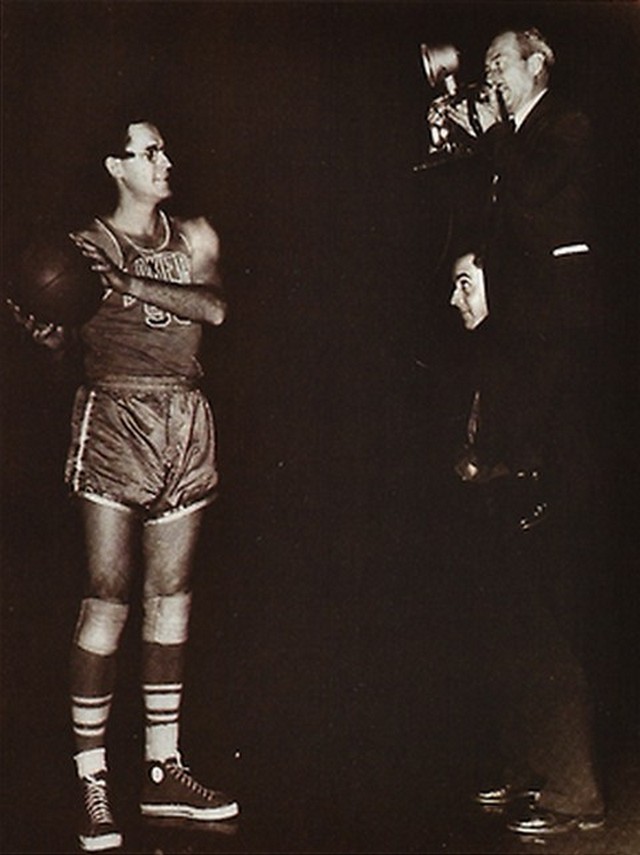 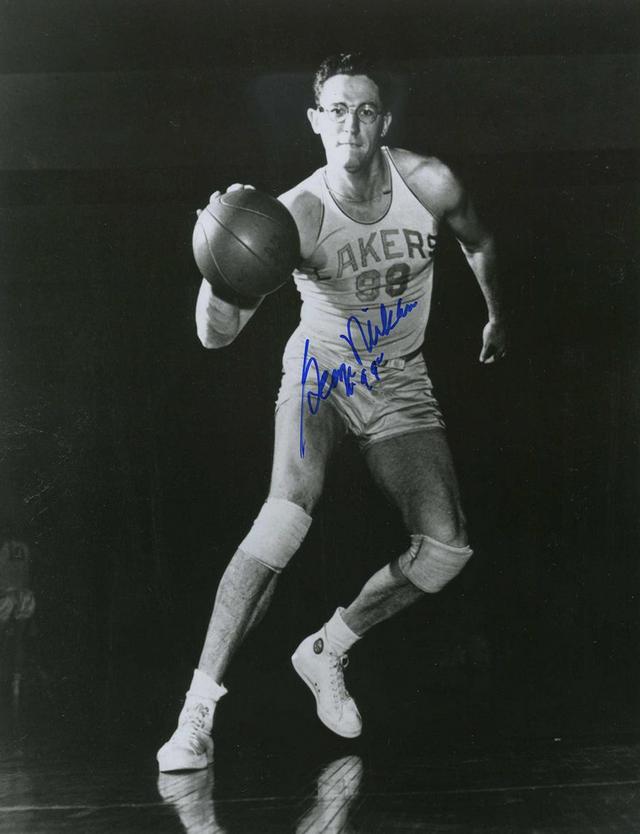 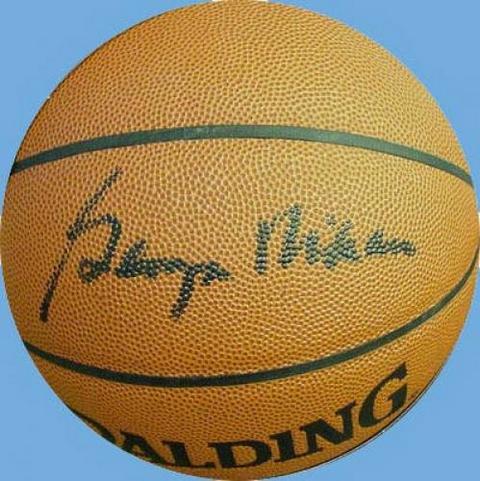 Please, go to the next page below.
|
|
|
Comments
-
Comment #1
(Posted by Tomislav)
This is the best article about George Mikan until today.
Thanks Darko, you are a genius
Submit Comment
|
|